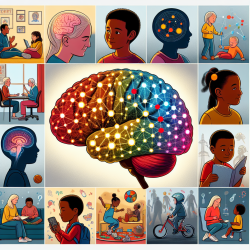Introduction
In the realm of special education, understanding the underlying causes of mental retardation (MR) is crucial for effective intervention and support. Recent advancements in genetic diagnostics have paved the way for more precise identification of chromosomal imbalances, which are often at the root of MR. One such advancement is the use of whole-genome array-CGH (comparative genomic hybridization), a powerful tool that allows for the detection of submicroscopic chromosomal abnormalities.
Understanding Whole-Genome Array-CGH
Whole-genome array-CGH is a technique that provides a high-resolution analysis of DNA copy number variations across the genome. This method is particularly beneficial for identifying microdeletions and duplications that are not detectable through conventional cytogenetic techniques. In the study conducted by Thuresson et al., array-CGH was used to screen 48 children with idiopathic MR and congenital malformations, leading to the identification of significant chromosomal imbalances in several cases.
Key Findings and Implications
The study revealed that array-CGH could detect de novo chromosomal imbalances in 4% of the cases, with additional suspected imbalances found in another 4%. These findings underscore the importance of using array-CGH as a diagnostic tool in cases where conventional methods fall short.
For practitioners, these findings suggest several actionable steps:
- Incorporate Array-CGH in Diagnostic Protocols: By integrating array-CGH into the diagnostic workflow, practitioners can enhance the accuracy of MR diagnoses, leading to more tailored interventions.
- Collaborate with Geneticists: Working closely with geneticists can help in the interpretation of array-CGH results, ensuring that the identified imbalances are accurately understood and addressed.
- Stay Informed on Genetic Research: Continuous education through conferences, publications, and webinars is essential to keep abreast of the latest developments in genetic diagnostics.
Encouraging Further Research
While the study by Thuresson et al. provides valuable insights, it also highlights the need for further research. The relatively low yield of de novo findings compared to other studies suggests that patient selection criteria might influence the effectiveness of array-CGH. Practitioners are encouraged to engage in or support research that explores these variables, potentially leading to improved diagnostic protocols.
Conclusion
Whole-genome array-CGH represents a significant advancement in the diagnostic capabilities for mental retardation. By adopting this technology, practitioners can improve their diagnostic accuracy, ultimately enhancing the educational and therapeutic outcomes for children with MR. For those interested in delving deeper into the research, the original study offers a comprehensive exploration of the methodology and findings.
To read the original research paper, please follow this link: Whole-genome array-CGH for detection of submicroscopic chromosomal imbalances in children with mental retardation.










